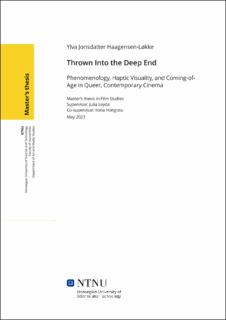| dc.contributor.advisor | Leyda, Julia | |
| dc.contributor.advisor | Hongisto, Ilona | |
| dc.contributor.author | Haagensen-Løkke, Ylva Jonsdatter | |
| dc.date.accessioned | 2023-07-01T17:33:48Z | |
| dc.date.available | 2023-07-01T17:33:48Z | |
| dc.date.issued | 2023 | |
| dc.identifier | no.ntnu:inspera:137202534:34431113 | |
| dc.identifier.uri | https://hdl.handle.net/11250/3075224 | |
| dc.description.abstract | På 1980- og 90-tallet ble det lagt ned stor innsats for å legitimere filmteori som akademisk disiplin. Del av legitimeringen innebar lån av teorier fra andre fagfelt. Spesielt populært var lån fra psykoanalytiske, Marxistiske, og semiotiske teorier. Filmteorietiker Vivian Sobchack ville distansere seg fra disse teoriene da hun i 1992 reintroduserte fenomenologisk filosofi til filmteorien. Hennes teorier som anser filmen som en fysisk, aktiv kropp, og teoriene førte til en underkategori av filmvitenskapen som tar for seg det Laura Marks døpte «haptisk visualitet». Haptisk visualitet prøver å svare på spørsmål som: hva om filmer har en kropp som er i kontakt med publikum og som fører til flersanselige opplevelser på en måte optisk visualitet ikke tar for seg? Denne oppgaven bruker haptisk visualitet kombinert med teorier om berøring foreslått av Jennifer Barker og Sara Ahmeds skeive fenomenologi som metodologisk pekepinn for å svare på to spørsmål: hvilke audiovisuelle elementer karakteriserer det haptiske i skeiv samtidsfilm, og hvilken effekt har de haptiske elementene på publikums forståelse av skeive karakterers kroppslige opplevelser? Gjennom analyse av mise-en-scène, kinematografi, narrative elementer og haptisk lyd i Sciammas Water Lilies (2007) og Tomboy (2011), argumenterer jeg for at de haptiske elementene oppfordrer til kroppslige opplevelser knyttet til de skeive karakterene. Haptisk film er en fruktbar innfallsvinkel for å forstå de flersanselige representasjonene av skeivhet på skjermen, og det tillater en mer flersidig forståelse av skeive kropper enn tradisjonell, optisk visualitet. | |
| dc.description.abstract | During the 1970s and 1980s there were major efforts exerted to legitimise film theory as an academic discipline. To do this, leading theorists borrowed from other fields of study, among which psychoanalysis, Marxism, and semiotics were most popular. Vivian Sobchack wanted to distance herself from these branches of film studies when she in 1992 reintroduced phenomenological philosophy as a way of understanding the filmic experience. Her theories regard film as a physical, acting body, and they spawned a subsection of film theory that dealt with what Laura Marks named “haptic visuality” which seeks to answer questions such as: what if films have bodies that act upon the audience and produce multi-sensory experiences in a way that optical visuality does not account for? This thesis uses haptic visuality as a methodological guide combined with theories of touch proposed by Jennifer Barker and the queer phenomenology of Sara Ahmed to answer two questions: What audiovisual elements best exemplify queer haptics in contemporary cinema, and how do the elements affect the spectator's understanding of queer characters’ lived-body experiences? Through analysis of mise-en-scène, cinematography, narrative elements, and haptic sound in Sciamma’s films Water Lilies (2007) and Tomboy (2011), this thesis argues that the haptic elements incite the feelings of queerness and lived-body experiences of the characters in the audience. Haptic cinema is a fruitful gateway into accounting for the multisensory representations of queerness on screen, and it allows for a more multifaceted understanding of on-screen bodies than traditional, optical visuality. | |
| dc.language | eng | |
| dc.publisher | NTNU | |
| dc.title | Thrown Into the Deep End: Phenomenology, Haptic Visuality, and Coming-of-Age in Queer, Contemporary Cinema | |
| dc.type | Master thesis | |
